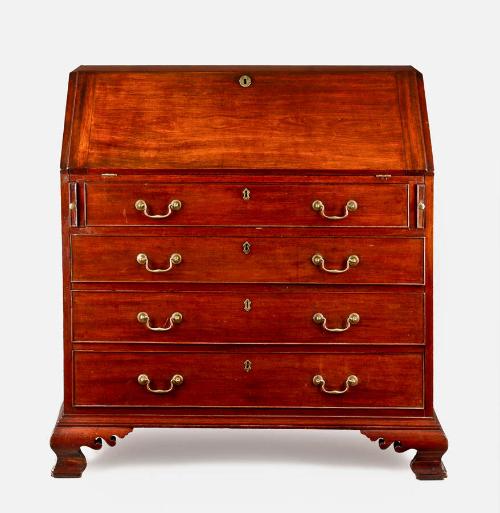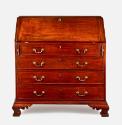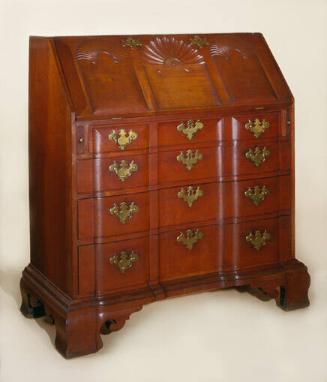Slant-front Desk
Original OwnerOriginally owned by
Ruth Parker
MakerMade by
Unknown
Date1780-1800
MediumMahogany veneer and primary wood, eastern white pine, cherry and maple secondary wood, brass hardware
DimensionsPrimary Dimensions (overall height x width x depth): 34 3/8 x 44 x 21 9/16in. (87.3 x 111.8 x 54.8cm)
ClassificationsFurniture
Credit LineMuseum purchase, through a gift from J. M. K. Davis, F. Kelso Davis, Edith D. Taylor, Leverett B. Davis, and Martha Davis Parsons, in memory of Newton Case Brainard
Object number1966.85.0
DescriptionMahogany veneered slant-front desk in the Chippendale, or rococo, style. The desk arrangement consists of a slant front above four graduated drawers. The top drawer is slightly narrower than the others and is flanked by a loper, or thin board that pulls out to form a support for the slant front when open. Base molding is located at the bottom of the front and sides of the case. Each ogee bracket foot projects boldly beyond the front and sides of the case; each foot has a small pad. Each knee bracket return has two deep scrolls that curve inward.
The interior arrangement of the desk consists of three stacked drawers in the center flanked by four pigeonholes over two drawers in a line. A row of complex molding is applied below the pigeonholes and drawers. The top drawer has a recessed, carved shell consisting of fourteen projecting rays. At the top of each pigeonhole is a valance with a lower edge shaped with a cyma curve, or S-curve, and a reverse cyma curve. Alternating vertical partitions between the pigeonholes each have a front edge shaped with a sharply-curved C-scroll at the top that tapers outward at the bottom. Hardware on the desk includes an oval brass lock escutcheon at the top center edge of the slant front. The slant front pivots open on a pair of hinges at the bottom edge. Each exterior drawer has a small, shield-shaped, brass lock escutcheon flanked by a ring-and-bail pull. Each interior drawer has a small brass knob.
Condition: The bottom right exterior drawer runner is detached. There is blue stain on portions of the underside of some of the drawers and on the top of the drawer dividers.
Design and Construction Details:
Case Construction. The top and bottom are dovetailed to the case sides. The backboards are horizontally oriented and are nailed into rabbets in the case sides. The base molding is nailed to the front and sides of the case. Each ogee bracket foot is constructed of molded ogee facing applied to shaped supports; a corner block and triangular glue blocks provide additional support for each foot. The back of each rear foot does not have molded ogee facing; the back is supported by a plain bracket with a curved edge.
Drawer Construction. Each drawer divider is veneered and is joined to the case with a sliding dovetail; these dovetails are concealed by a facing strip on the front edge of each side of the case. The vertical partitions between the top exterior drawer and the lopers each slide into grooves in the rail above and the drawer divider below. The top drawer and the lopers are supported on each side by a board that fits into a sliding dovetail in the case side; a drawer guide separates each loper from the top drawer. The drawer runners for the second and third drawers fit into sliding dovetails in the case sides. The drawer runners for the bottom drawer are glued to the sides and bottom of the case. Small, vertical blocks are nailed to the back corners of the case to serve as drawer stops. Each exterior drawer front and each loper is outlined by cock beading. The drawer sides are rounded on top. Each drawer bottom fits into grooves in the front and sides of the drawer and is nailed at the back. Each bottom extends past the back of the drawer to form a drawer stop. The bottom of each interior drawer slides into canted grooves on the lower portion of the drawer sides.
The interior arrangement of the desk consists of three stacked drawers in the center flanked by four pigeonholes over two drawers in a line. A row of complex molding is applied below the pigeonholes and drawers. The top drawer has a recessed, carved shell consisting of fourteen projecting rays. At the top of each pigeonhole is a valance with a lower edge shaped with a cyma curve, or S-curve, and a reverse cyma curve. Alternating vertical partitions between the pigeonholes each have a front edge shaped with a sharply-curved C-scroll at the top that tapers outward at the bottom. Hardware on the desk includes an oval brass lock escutcheon at the top center edge of the slant front. The slant front pivots open on a pair of hinges at the bottom edge. Each exterior drawer has a small, shield-shaped, brass lock escutcheon flanked by a ring-and-bail pull. Each interior drawer has a small brass knob.
Condition: The bottom right exterior drawer runner is detached. There is blue stain on portions of the underside of some of the drawers and on the top of the drawer dividers.
Design and Construction Details:
Case Construction. The top and bottom are dovetailed to the case sides. The backboards are horizontally oriented and are nailed into rabbets in the case sides. The base molding is nailed to the front and sides of the case. Each ogee bracket foot is constructed of molded ogee facing applied to shaped supports; a corner block and triangular glue blocks provide additional support for each foot. The back of each rear foot does not have molded ogee facing; the back is supported by a plain bracket with a curved edge.
Drawer Construction. Each drawer divider is veneered and is joined to the case with a sliding dovetail; these dovetails are concealed by a facing strip on the front edge of each side of the case. The vertical partitions between the top exterior drawer and the lopers each slide into grooves in the rail above and the drawer divider below. The top drawer and the lopers are supported on each side by a board that fits into a sliding dovetail in the case side; a drawer guide separates each loper from the top drawer. The drawer runners for the second and third drawers fit into sliding dovetails in the case sides. The drawer runners for the bottom drawer are glued to the sides and bottom of the case. Small, vertical blocks are nailed to the back corners of the case to serve as drawer stops. Each exterior drawer front and each loper is outlined by cock beading. The drawer sides are rounded on top. Each drawer bottom fits into grooves in the front and sides of the drawer and is nailed at the back. Each bottom extends past the back of the drawer to form a drawer stop. The bottom of each interior drawer slides into canted grooves on the lower portion of the drawer sides.
Status
Not on view














